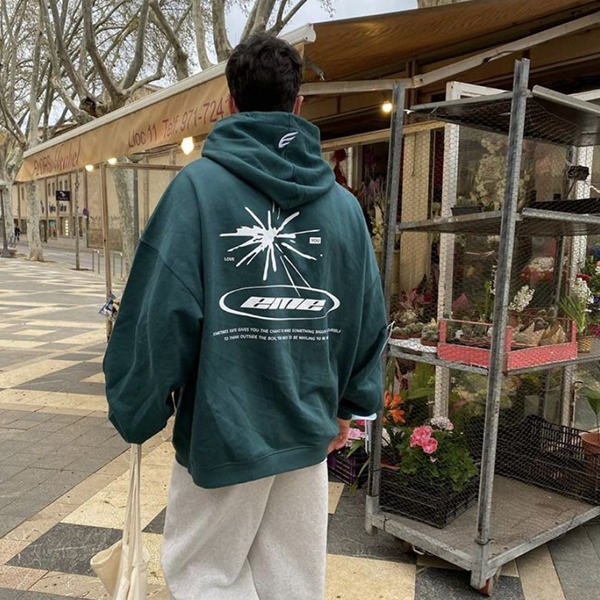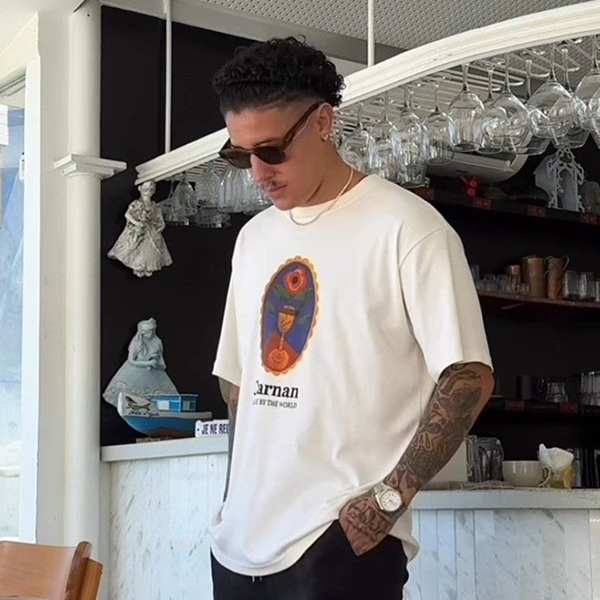There’s a quiet revolution happening in fashion — one that doesn’t rely on sequins, logos, or silhouettes. It’s made of cotton. It’s cut simply. It’s called the T-shirt.
For something so ordinary, the T-shirt is arguably the most extraordinary garment ever made. It has clothed soldiers, artists, rebels, lovers, and dreamers. It has carried slogans, symbols, and entire movements. It can be a blank canvas or a battle flag.
And yet, in 2025, the T-shirt is more relevant than ever. Because in a world of excess, simplicity has become the ultimate luxury.
1. The Humble Beginning
Before it became a style statement, the T-shirt was pure function.
In the late 19th century, it was underwear — worn beneath uniforms to absorb sweat. U.S. Navy sailors in the early 1900s adopted it for comfort in hot conditions. By the 1950s, Hollywood icons like Marlon Brando and James Dean made it a symbol of rebellion, masculinity, and effortless cool.
One garment. One decade. One cultural explosion.
The T-shirt went from being an undergarment to the garment — a declaration of individuality and attitude.
2. The Democratization of Style
The beauty of the T-shirt is that it belongs to everyone.
There’s no hierarchy in a tee. Billionaires and baristas wear it the same way. It flattens social boundaries — a rare quality in fashion.
In an age where luxury once meant exclusivity, the T-shirt flipped the script. Now, true luxury is comfort, confidence, and consciousness.
When you pull on a perfectly cut white tee, you’re not dressing up or down. You’re dressing authentically.
3. The Anatomy of a Perfect Tee
To the untrained eye, a T-shirt is simple. But true design lies in precision.
The perfect tee has invisible architecture — balance, proportion, and feel.
A few millimeters off the collar, and it loses sharpness. The weight of the cotton determines drape. The sleeve length changes the entire silhouette.
Modern brands like Trendytroop understand this mastery:
- Fabric: Premium combed cotton or organic blends that breathe and age gracefully.
- Fit: Tailored through the shoulders, relaxed through the body.
- Seams: Reinforced but invisible.
- Finish: Clean hems, no gimmicks.
When done right, a T-shirt isn’t basic — it’s refined minimalism.
4. The Language of Simplicity
The T-shirt speaks softly, but clearly.
It’s democratic yet personal. It doesn’t scream for attention — it earns it.
Every crease and fade tells a story: the gigs you’ve danced at, the people you’ve met, the nights that never ended.
Unlike fast-fashion garments that come and go, a good tee lives with you. It records time. It becomes your signature.
That’s why style icons from Steve Jobs to Rihanna to Timothée Chalamet all return to the same formula: jeans, sneakers, and a perfect T-shirt.
Because style isn’t about complexity — it’s about clarity.
5. The Tee as Protest and Identity
Few garments carry the political and cultural weight of a T-shirt.
From “Black Lives Matter” to “We Should All Be Feminists,” from punk anarchy to environmental activism — the tee has been fashion’s loudest megaphone.
In the 1970s, Vivienne Westwood turned it into rebellion. In the 2000s, Supreme turned it into exclusivity. In 2020s, Gen Z turned it back into authenticity.
The T-shirt is now a tool for storytelling — personal, political, or poetic.
Prints aren’t just decoration anymore. They’re declarations.
6. The Rise of the Conscious Tee
In today’s fashion landscape, ethics are the new aesthetics.
Consumers don’t just buy T-shirts — they buy into values. They ask:
- Where was this cotton grown?
- Who made it?
- How much water was used?
That’s why brands like Trendytroop have shifted toward sustainable tees —
crafted from organic cotton, recycled fibers, and low-impact dyes.
Even the smallest label placement or tag choice reflects intention.
Because the modern customer doesn’t just want to look good. They want to do good.
7. The Tee as a Modern Uniform
In creative circles, the T-shirt is the new power suit.
Designers wear it in studios. Founders pitch in it. Artists paint in it.
It’s the garment of focus — one that doesn’t distract from the work.
Mark Zuckerberg’s gray tee became symbolic of clarity. Virgil Abloh turned it into art. Phoebe Philo turned it into quiet authority.
The uniformity of the tee doesn’t erase individuality — it amplifies it. Because when the clothing disappears, the person appears.
8. Gender Fluidity and the Universal Fit
The T-shirt transcends gender, culture, and shape.
It’s one of the few truly universal garments — adaptable to whoever wears it.
Oversized tees became empowerment for women; cropped tees became playfully subversive. Meanwhile, gender-neutral cuts took center stage, redefining fit as freedom.
Fashion’s future isn’t about who it’s for — it’s about how it feels.
And nothing feels as effortless as a soft, well-made tee.
9. The Minimalist Renaissance
After years of maximalism — logos, prints, and hype drops — fashion is returning to minimalism.
The white tee has become the new status symbol, precisely because it doesn’t try.
It’s the mark of those who’ve outgrown the need to prove.
Quiet luxury isn’t about price tags; it’s about permanence.
The modern T-shirt reflects that ethos perfectly — unbranded, thoughtful, and timeless.
10. The Tee as Canvas: Art Meets Fabric
Artists have always been drawn to the T-shirt — not just as clothing, but as medium.
From Jean-Michel Basquiat’s raw scribbles to contemporary graphic collectives, the tee has served as portable art.
In the age of NFTs and digital fashion, the physical tee still holds weight — because it’s tangible. It’s human. It’s real.
The future of T-shirts may integrate digital prints, heat-reactive materials, or AR-coded designs, but the soul will remain the same: art on cotton, worn by the world.
11. The Global Tee Culture
Every city has its own relationship with the T-shirt:
- New York: monochrome minimalism, sharp silhouettes.
- Tokyo: playful layers and textures.
- Paris: slim fit, tucked into tailored trousers.
- Los Angeles: vintage, sun-faded, unstructured.
- Saigon: cropped, airy, with a sense of ease.
The T-shirt is the world’s connective tissue — a visual language that requires no translation.
12. The Future of the T-shirt
As sustainability, craftsmanship, and culture merge, the future of the T-shirt looks intelligent.
Expect to see innovations like:
- Biodegradable cotton blends.
- Modular cuts that extend lifespan.
- Smart fabrics that regulate temperature.
But more than that, the emotional connection will deepen.
In a fast world, people crave familiarity. And few garments feel as intimate as the T-shirt — soft, lived-in, and always waiting by the bed.



